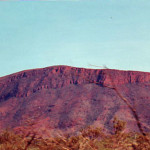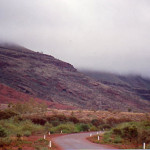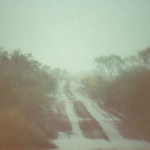Hazards of Mining in the Australian Bush-Part 1
By Neville Ryan
While Australia doesn’t have have the political problems surrounding the mining of LAPIS in Afghanistan or the physical extremes of hand mining NEPALI CRYSTALS
in the Himalayas, we did have our own set of problems mining in north west Western Australia.
Distance is the first problem to overcome. If traveling from Perth, on the west coast, you would have to allow 1,000 miles on paved roads plus anywhere up to 500 miles on dirt roads. If traveling from the east coast another 2,000 to 3,000 miles would have to be added. You can see why Perth is the most desirable staging point. The fuel bill for a truck averaging 8 miles to the gallon plus support vehicles can add up to a tidy sum before a rock has been mined. Add on vehicle repairs, tire replacements and equipment repair and the costs can escalate very quickly. On one mining trip we blew a hydraulic hose on the backhoe. That meant a 250 mile drive over dirt roads to the coast and the town of Karratha, to order the hose from Melbourne (3,000 miles away in south eastern Australia) then drive back to camp 250 miles and wait for days while it was delivered to Karratha by bus. Another 500 mile round trip to pick up the hose and we were back in business.
The term “dirt roads” can cover a multitude of sins. It can vary from wide well maintained dirt roads to the other extreme of bush tracks. The
biggest problem with dirt roads is that after a time, striations or ruts start to develop on the road. These are small ridges that are formed by tires bouncing on the road surface. The more vehicles that use the road the bigger the ruts become. If you were lucky and a grader had been through recently you could look forward to a good drive. A grader is a machine that basically scrapes the top of the dirt road flattening out the ruts. This rarely happens however, which means you have to deal with bone jarring vibrations which are neither good for vehicles or passengers. The only way to overcome this is to reach an optimum speed where the tires are in sync with the ruts and the vibrations decrease to a bearable level. Usually around 45mph to 50mph seemed to be the mark. There is one problem that you have to be aware of when driving like this in the bush. The vibrations and the scenery never seem to change for mile after mile. Add to this the fact that you have been driving 100 miles without a bend in the road and the situation becomes almost hypnotic. This hypnotic reverie is shattered when you suddenly realize you are heading towards a sharp bend in the road at 45mph in a fully loaded truck with a backhoe swaying from side to side. Believe it or not I had forgotten the backhoe was there. It became a matter of hitting the brakes before the bend to slow down as much as possible and then gently accelerate out of the turn hoping that the the truck, backhoe and me didn’t end up on our side in a shattered mess. Just as I reached the sharpest part of the bend everything seemed to move in slow motion as that sickening feeling struck the pit of my stomach and I just knew that the truck and the backhoe were going over. It felt as if the outside tires had lifted off the ground and the backhoe boom was trying to reach down and touch the dirt. Through good fortune, more than good driving, all turned out well and with heart pounding I carried on towards the mine site.
Surprisingly, rain can also create problems. When it does rain it is typically from the tail of a cyclone and it can vary from light showers to a
tropical downpour that could last for days which makes most of the dirt roads impassable. The decision then is to stay and hope the rainfall is light or make a run for it and try to get to a paved road while it is still possible. If the rainfall is heavy and you are stuck it might be several weeks before you can get out of the area. Lack of drinking water, food and deplorable living conditions usually mean “Let’s get the hell out of here”! One time we were heading back to Perth before the main part of the storm hit and the truck became bogged. We chained the backhoe and Toyota 4WD to the truck and with all 3 engines roaring and tires spinning we managed to move the truck about an inch. After several hours of struggle a committee formed and the conclusion was that we hide the backhoe and leave the truck where it was until next year. When we came back the next year, no one had been there, and we simply drove the truck out of what was a previously impassable area. It did, however, take awhile to find the backhoe!
One time we were exploring in a 4WD when the rain started bucketing down. Not having any supplies we decided to make a run for it. That meant driving down water covered dirt roads at speeds of 40mph to 50mph plowing through puddles that were up to 50 yards long. If we went slowly we would have been bogged so we had to keep the speed up. Quite an experience hitting water at that speed. The entire vehicle is covered and it is impossible to see anything. You have to keep going and hope that no logs or rocks are on the road and hopefully the road hasn’t washed away. We eventually made it to the paved road and managed to get to town.
To be continued…………I



